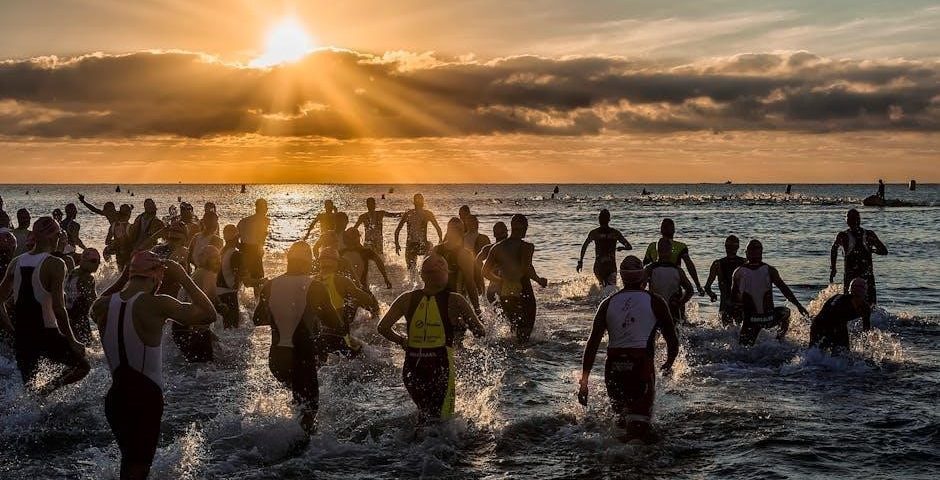An Ironman triathlon is a demanding endurance event requiring a structured training plan․ It involves a 2․4-mile swim, 112-mile bike ride, and 26․2-mile run, pushing athletes to their limits․ A well-designed plan ensures gradual progression, injury prevention, and peak race readiness, making it essential for both newcomers and experienced triathletes to follow a tailored approach․
1․1 Understanding the Ironman Distance
The Ironman distance is a formidable challenge, consisting of a 2․4-mile swim, 112-mile bike ride, and 26․2-mile run․ Completing this in under 17 hours demands exceptional endurance, mental toughness, and meticulous preparation․ Athletes must grasp the scale of each discipline to build a realistic training foundation․ The swim requires efficiency and stamina, while the bike portion tests aerobic capacity and muscular endurance․ The run, often considered the most mentally daunting, pushes athletes to maintain pace despite fatigue․ Understanding these components helps triathletes prioritize specific training areas, ensuring they are adequately prepared for race day․ A structured plan is essential to progressively build the necessary fitness and resilience, avoiding burnout or injury․ Each segment of the Ironman distance presents unique challenges, making a comprehensive approach vital for success․
1․2 Importance of a Structured Training Plan
A structured training plan is crucial for Ironman success, providing a clear roadmap to race readiness․ It ensures balanced progression across swimming, cycling, and running, preventing overtraining and injury․ By breaking the journey into manageable phases, athletes build aerobic fitness, endurance, and race-specific skills․ A well-designed plan includes periodized workouts, strength training, and recovery strategies, optimizing performance while maintaining consistency․ Without structure, athletes risk plateaus or burnout, especially given the demands of a 2․4-mile swim, 112-mile bike, and 26․2-mile run․ A structured plan also helps mentally, offering accountability and confidence as race day approaches․ It’s tailored to individual needs, ensuring each session contributes to the ultimate goal․ Thus, a structured plan is indispensable for achieving peak performance and crossing the Ironman finish line successfully․
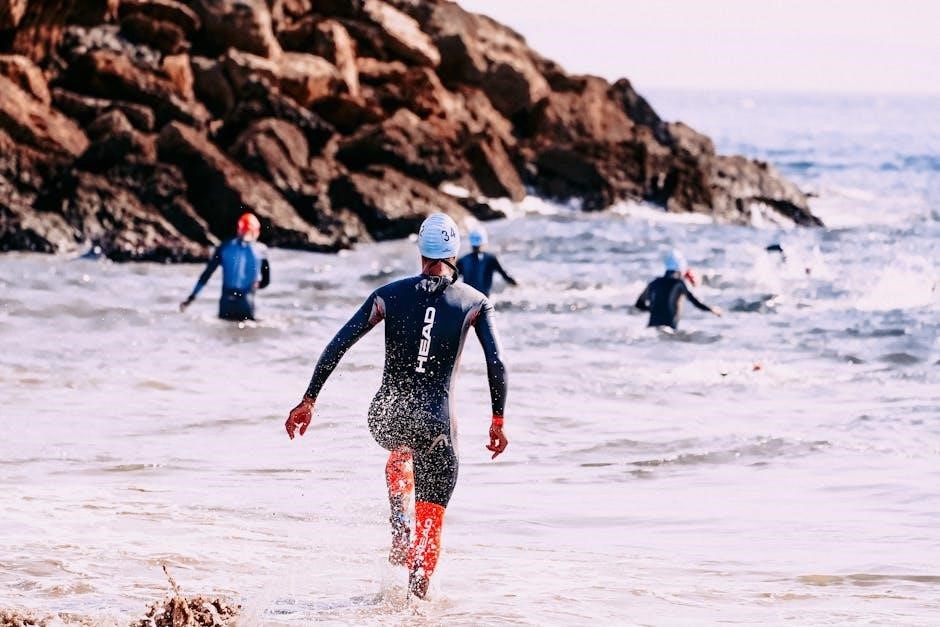
Structure of an Ironman Training Plan
An Ironman training plan is built around periodized phases, gradual weekly volume progression, and balanced workouts across swimming, cycling, and running․ This structure ensures sustained progress and peak race-day readiness․
2․1 Overview of the Training Phases
An Ironman training plan typically consists of three distinct phases: Base, Build, and Taper․ The Base Phase focuses on building aerobic endurance and foundational fitness, lasting several months․ It emphasizes consistent, low-to-moderate intensity workouts across all three disciplines․ The Build Phase introduces race-specific workouts, higher intensity sessions, and increased volume to enhance speed and endurance․ This phase includes brick sessions, simulating race-day transitions․ Finally, the Taper Phase reduces training volume to allow recovery, ensuring peak performance on race day․ Each phase is designed to progressively build fitness, adapt to demands, and prevent injury․ Proper progression through these phases is crucial for achieving optimal race readiness and maximizing performance․
2․2 Weekly Volume and Progression
A well-structured Ironman training plan progresses gradually to avoid overtraining and injury․ Weekly volume typically starts low and increases systematically, with periods of recovery․ For example, a 12-week plan might begin with 10-12 hours of training per week, including swim, bike, and run sessions, and peak at 15-18 hours before tapering․ This progression ensures athletes adapt to the demands of each discipline․ The plan balances endurance-building long sessions with shorter, high-intensity workouts to improve speed and efficiency․ Strength training is also integrated to enhance overall resilience․ Weekly volume is carefully calibrated to allow for recovery, with rest days or low-intensity sessions․ Consistency and adherence to the plan are key to achieving race readiness․ Proper progression ensures athletes build fitness steadily, avoiding plateaus and injuries, while staying motivated throughout the journey to race day․
2․3 Balancing Swim, Bike, and Run Workouts
Balancing swim, bike, and run workouts is crucial for an effective Ironman training plan․ Each discipline demands specific focus to build endurance, technique, and race-specific skills․ Swimming workouts emphasize stroke efficiency and endurance, often including drills and interval training․ Cycling sessions focus on building leg strength and cardiovascular fitness, with long rides and high-intensity intervals․ Running workouts aim to improve pace management and endurance, incorporating tempo runs and long-distance sessions․ A typical week includes 3-4 sessions per discipline, with cross-training and strength exercises to enhance overall performance․ The balance ensures equal development across all three sports, preventing overtraining in one area while neglecting others․ This holistic approach minimizes injury risk and maximizes race readiness․ By dedicating equal attention to each discipline, athletes achieve a well-rounded fitness level essential for the demands of an Ironman triathlon․ Proper balance also helps maintain mental and physical motivation throughout the training journey․ Consistency across all three sports is key to achieving peak performance on race day․

Key Components of the Training Plan
A successful Ironman training plan includes swimming, cycling, and running workouts, along with strength training for injury prevention․ Each component is tailored to build endurance, speed, and race-specific skills, ensuring comprehensive preparation for race day․
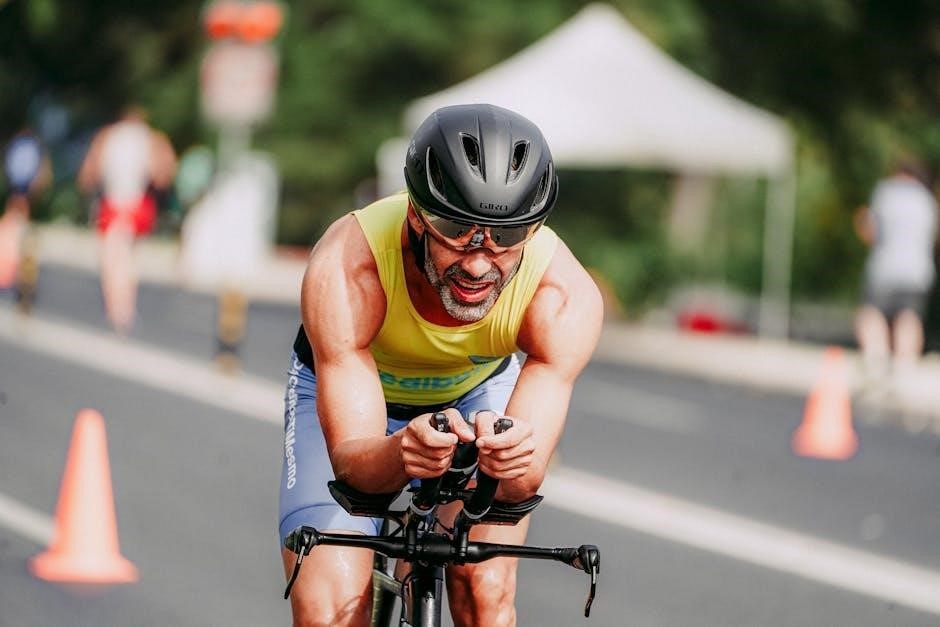
3․1 Swimming Workouts and Techniques
Swimming workouts are a cornerstone of Ironman training, focusing on building endurance, speed, and technique․ Plans often include drills to improve stroke efficiency, such as freestyle and open-water skills․ Athletes typically swim 3-4 times weekly, with sessions varying from endurance swims to high-intensity intervals․ Strength training, like pull sets with paddles, enhances power․ Race-specific techniques, such as sighting and drafting, are also emphasized․ Progression is key, with distances gradually increasing to match race demands․ Proper recovery and form are stressed to prevent injuries․ These structured workouts ensure swimmers are ready for the 2․4-mile open-water challenge, building confidence and stamina for the first leg of the triathlon․
3․2 Cycling Training and Endurance Building
Cycling is a critical component of Ironman training, requiring a focus on endurance, speed, and technique․ Training plans typically include 3-4 bike sessions per week, with a mix of endurance rides, high-intensity intervals, and race-specific workouts․ Long rides, often exceeding 100 miles, are essential for building mental and physical resilience․ Brick sessions, which combine cycling and running, simulate race conditions and enhance transitions․ Strength training, such as low-cadence drills, improves power output․ Proper nutrition and hydration strategies are emphasized during rides to mimic race-day fueling․ Progression is gradual, with increasing distance and intensity over time․ Athletes are encouraged to incorporate race-pace efforts and cadence drills to refine their biking skills․ Recovery rides at low intensity are also crucial to avoid overtraining․ A well-structured cycling plan ensures athletes are prepared for the demanding 112-mile bike segment of the Ironman, building both endurance and confidence․
3․3 Running Sessions and Pace Management
Running is the final discipline in an Ironman triathlon, requiring a strategic approach to build endurance and manage pace effectively․ Training plans include 3-4 runs per week, combining endurance runs, interval training, and race-specific workouts․ Long slow distance (LSD) runs are crucial for building stamina, while interval sessions enhance speed and lactate threshold․ Brick sessions, which involve running immediately after cycling, simulate race transitions and improve overall efficiency․ Proper pacing is emphasized to avoid burnout, with workouts structured around heart rate zones or perceived exertion․ Strength training for the lower body is also integrated to prevent injuries and improve running efficiency․ Race-pace runs and cadence drills are introduced to refine running technique and mental resilience․ By balancing intensity with recovery, athletes can optimize their performance, ensuring they are prepared for the demanding 26․2-mile run that concludes the Ironman event․
3․4 Strength Training for Injury Prevention
Strength training is a critical component of an Ironman triathlon training plan, serving as a foundation for injury prevention and overall performance enhancement․ By incorporating strength exercises, athletes build muscular resilience and stability, which are essential for withstanding the repetitive demands of swimming, cycling, and running․ A well-structured strength program focuses on key areas such as the lower body, core, and upper body, with exercises like squats, lunges, step-ups, and planks․ These workouts improve joint stability, enhance neuromuscular coordination, and reduce the risk of overuse injuries․ Strength sessions are typically performed 1-2 times per week, with a focus on controlled movements and progressive overload․ Additionally, mobility and flexibility exercises are integrated to prevent muscle tightness and imbalances․ Over time, this approach not only protects against injuries but also contributes to improved endurance and race performance, making it an indispensable part of a comprehensive Ironman training plan․
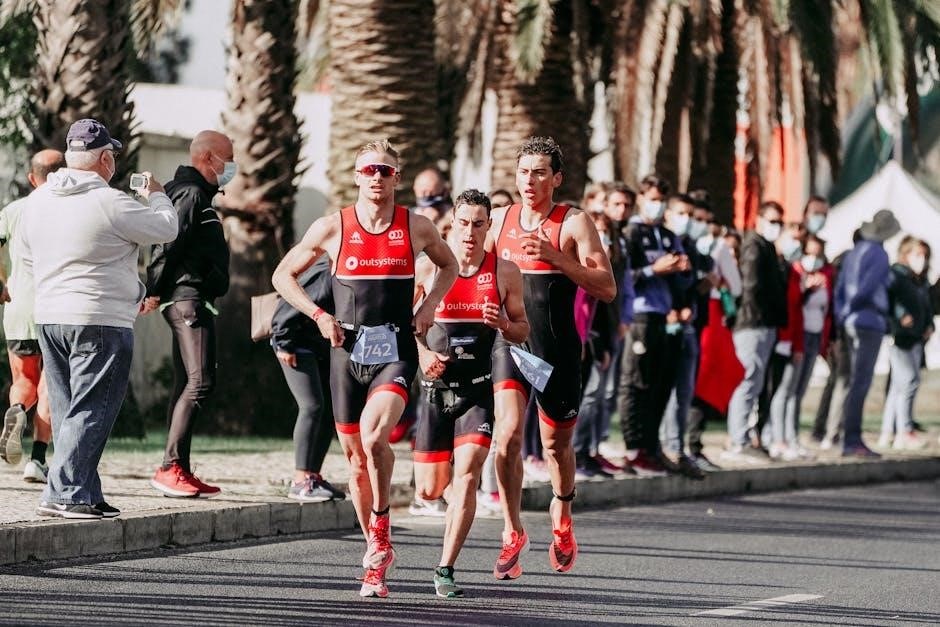
Phases of Training
The training process is divided into distinct phases: base, build, and taper․ Each phase serves a specific purpose, ensuring progressive adaptation, race-specific preparation, and optimal recovery to achieve peak performance on race day․
4․1 Base Training Phase
The base training phase is the foundation of an Ironman journey, typically lasting several months․ It focuses on building aerobic endurance, muscular strength, and overall durability․ During this phase, athletes engage in low-intensity, long-duration workouts across all three disciplines—swimming, cycling, and running․ The primary goal is to increase cardiovascular efficiency, improve muscular endurance, and establish a consistent training routine․ Strength training is also emphasized to prevent injuries and enhance overall stability․ This phase is crucial for developing the resilience needed for the more intense training that follows․ By gradually increasing volume and intensity, athletes build a solid base that supports future race-specific efforts․ The base phase sets the stage for more advanced training, ensuring athletes are prepared to handle the demands of the build phase and ultimately, race day․
4․2 Build Phase and Race-Specific Workouts
The build phase transitions athletes from foundational training to race-specific preparation, focusing on intensity and precision․ This phase introduces workouts mimicking race conditions, such as brick sessions combining bike-to-run transitions and open-water swims․ Athletes engage in race-pace efforts, building speed and endurance while refining race strategies․ The volume of training peaks, with a focus on simulating the demands of race day․ Strength training continues, but with a shift toward functional exercises that enhance race performance․ Recovery remains critical, as the increased intensity requires adequate rest to avoid burnout․ This phase is designed to sharpen skills, boost confidence, and ensure athletes are mentally and physically prepared for the challenges of the Ironman event․ By incorporating race-specific workouts, athletes fine-tune their pacing, nutrition, and transitions, laying the groundwork for a successful race day․
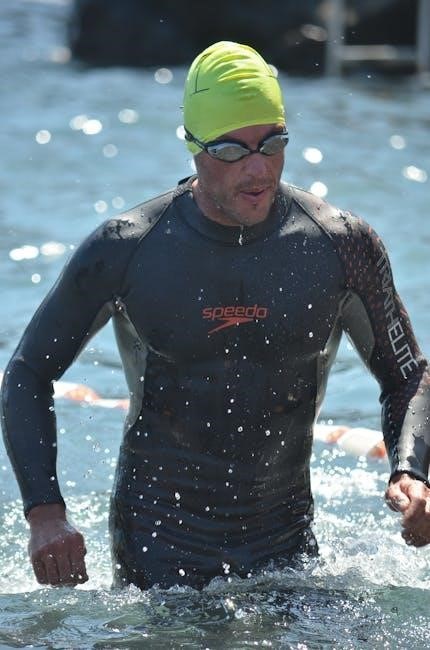
4․3 Taper Phase for Peak Performance
The taper phase is a critical period preceding race day, designed to optimize performance by allowing the body to recover and adapt․ During this phase, training volume is significantly reduced while maintaining intensity to preserve fitness gains․ The focus shifts to active recovery, ensuring that athletes arrive at the start line fresh and injury-free․ Workouts become more strategic, with an emphasis on race-specific drills and mental preparation․ Nutrition and hydration strategies are fine-tuned to maximize energy levels and endurance․ Rest and sleep are prioritized to enhance physical and mental rejuvenation․ The taper phase typically lasts two weeks, balancing reduced activity with targeted efforts to maintain sharpness․ By carefully managing this phase, athletes ensure they peak on race day, ready to tackle the Ironman challenge with optimal energy and focus․
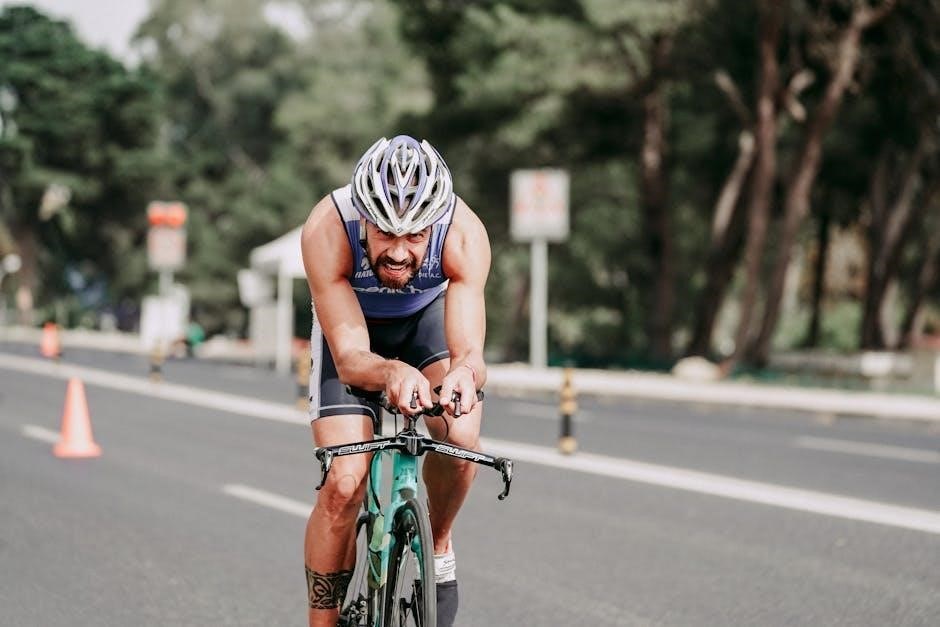
Nutrition and Recovery Strategies
Proper nutrition and recovery are vital for Ironman training․ A balanced diet, hydration, and electrolyte management fuel performance․ Recovery techniques like rest, stretching, and sleep aid in muscle repair and overall well-being․
5․1 Fueling for Long-Distance Training
Fueling for long-distance training is critical to sustain energy levels and optimize performance․ A balanced diet rich in carbohydrates, proteins, and fats provides the necessary energy for endurance workouts․ Carbohydrates are the primary fuel source, with recommendations of 8-12 grams per kilogram of body weight daily․ Hydration is equally important, with athletes advised to consume 500-750 mL of fluid per hour during training․ Electrolytes, such as sodium and potassium, must be replenished to prevent cramps and maintain fluid balance․
- Pre-workout meals should be consumed 2-3 hours in advance, focusing on easily digestible foods like oatmeal or bananas․
- During long sessions, energy gels or bars every 20-30 minutes help maintain glucose levels․
- Post-workout recovery requires a mix of carbohydrates and protein within 30 minutes to replenish glycogen stores․
Personalizing nutrition based on individual needs and training intensity ensures optimal fueling strategies for Ironman triathlon preparation․
5․2 Recovery Techniques and Rest Days
Recovery is a cornerstone of Ironman training, allowing the body to adapt and rebuild after intense workouts․ Rest days are essential for preventing overtraining and reducing the risk of injury․ Techniques like stretching, foam rolling, and self-myofascial release help improve flexibility and reduce muscle soreness․ Sleep is also critical, with 7-9 hours per night recommended to aid recovery and physical adaptation․
- Active recovery, such as light swimming or cycling, promotes blood flow without excessive strain․
- Cold water immersion or ice baths can reduce muscle inflammation and speed recovery․
- Massage therapy and compression garments further support muscle repair and circulation․
Nutrition plays a role in recovery, with post-workout meals rich in protein and carbohydrates helping to replenish energy stores; Listening to your body and incorporating rest days ensures long-term progress and peak performance on race day․
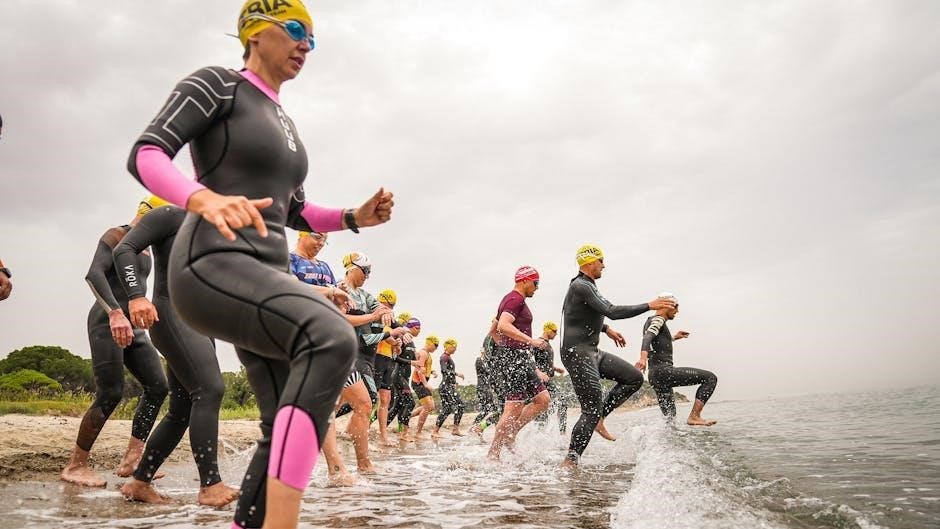
Mental Preparation and Race Strategy
Mental resilience is key to tackling the Ironman distance․ Techniques like visualization, positive affirmations, and mindfulness help build confidence․ Race strategy involves pacing, nutrition, and gear management to ensure optimal performance and a strong finish․
6․1 Building Mental Resilience
Mental resilience is crucial for Ironman success, as it helps athletes overcome challenges during training and racing․ Techniques like visualization and mindfulness can enhance focus and reduce anxiety․ Positive self-talk and setting realistic goals build confidence, while learning to manage setbacks fosters perseverance․ A structured training plan, including race-specific simulations, prepares the mind for race day․ Additionally, maintaining a consistent routine and surrounding oneself with a supportive community can strengthen mental toughness․ Prioritizing rest and recovery also plays a role in mental well-being․ By cultivating resilience, athletes can stay motivated and composed, even during the most demanding moments of the Ironman․
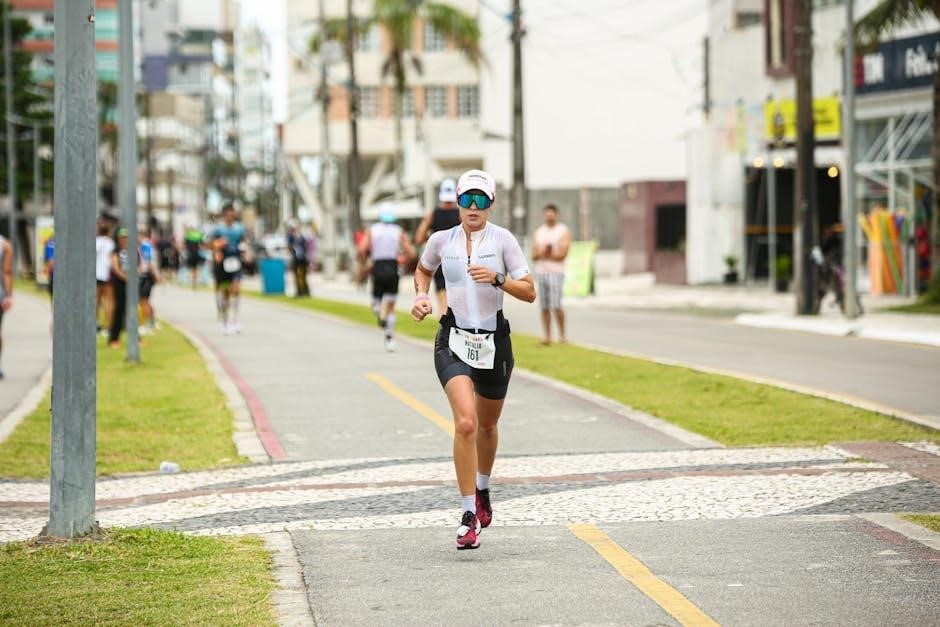
6․2 Race Day Strategy and Pacing
A well-executed race day strategy is vital for Ironman success․ Start with a conservative pace, especially in the swim and bike, to avoid early exhaustion․ Focus on maintaining a steady effort rather than chasing speeds, ensuring energy reserves for the final run․ Proper pacing prevents burnout and allows for a strong finish․ Practice race-specific scenarios during training, such as brick workouts, to simulate transitions and build adaptability․ Fueling and hydration plans should be meticulously rehearsed to avoid gastrointestinal issues․ Stick to the nutrition strategy developed during training to maintain energy levels․ Transition efficiency is key—practice quick changes to save precious time․ Stay mentally focused, breaking the race into manageable segments to maintain motivation․ Avoid distractions and trust the training plan․ By balancing discipline and adaptability, athletes can optimize their performance and achieve their goals on race day․
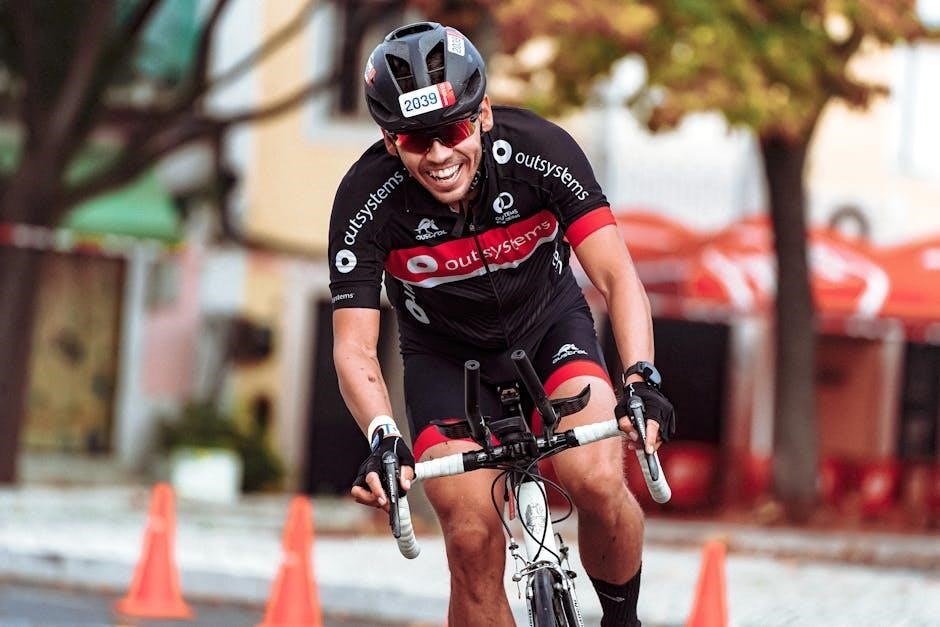
Downloadable Resources and Tools
Free Ironman training plan PDFs are available, offering structured schedules for all levels․ These resources include detailed workouts, race strategies, and nutrition advice, designed by certified coaches to help athletes prepare effectively․
7․1 Free Ironman Training Plan PDFs
Free Ironman training plan PDFs are widely available online, offering detailed and structured schedules for athletes preparing for the Ironman triathlon․ These plans cater to all levels, from beginners to advanced triathletes, and provide a roadmap to success․ Many PDFs include 12-week, 24-week, or even 6-month plans, ensuring gradual progression and peak race readiness․ Designed by certified coaches, these resources often feature weekly workouts, nutrition advice, and race strategies․ They emphasize building base fitness, endurance, and race-specific skills, with some plans focusing on simplicity for time-crunched athletes․ Downloadable PDFs allow athletes to track progress and stay organized․ Popular options include plans from trusted sources like Paragon Training and 220 Triathlon, offering comprehensive guides for conquering the Ironman 140․6 event․ These free resources are invaluable for anyone seeking a structured approach without hidden costs, making high-quality training accessible to all․
7․2 Using Training Apps and Trackers
Training apps and trackers are essential tools for Ironman triathletes, offering real-time data and personalized insights to optimize performance․ Apps like TrainingPeaks, Strava, and MyFitnessPal provide detailed workout tracking, enabling athletes to monitor progress and stay consistent․ These platforms often integrate with wearable devices, such as heart rate monitors and GPS trackers, to collect data on swimming, cycling, and running metrics․ Customizable dashboards allow users to set goals, analyze performance trends, and adjust training plans accordingly․ Additionally, many apps offer social features, connecting athletes with a community for motivation and support․ By leveraging technology, triathletes can streamline their training, enhance accountability, and make data-driven decisions to achieve peak performance․ These tools complement PDF training plans, providing a holistic approach to preparing for the demands of an Ironman event․
Completing an Ironman triathlon is a monumental achievement that requires dedication, resilience, and a well-structured training plan․ The journey from base training to race day is a transformative process that pushes athletes to their limits․ By following a comprehensive training plan, triathletes can build the endurance, strength, and mental toughness needed to succeed․ The resources provided, including free PDF training plans and tracking tools, offer a roadmap to success, ensuring athletes stay on track and motivated․ Remember, consistency and patience are key․ Celebrate small victories along the way, and trust the process․ With the right mindset and preparation, crossing the Ironman finish line is within reach․ Embrace the challenge, stay committed, and unlock your full potential as an endurance athlete․
